![Portfolio diversification]() In this article you will learn:
In this article you will learn:
- The importance of diversification
- Key rules of diversification
- How to diversify your portfolio with CFDs
- Portfolio diversification with commodities
Every investor has probably heard of portfolio diversification at a certain stage of their investing career. It is perceived as an absolutely essential part of institutional investors’ strategies. However, the importance of diversification among retail investors often tends to be overlooked. Many might wonder - what exactly does diversification mean and how do you diversify your portfolio? In this article, we try to answer those and similar questions.
The importance of diversification
The idea behind portfolio diversification is actually very intuitive. It is all about opening multiple positions in order to reduce the total risk of the portfolio. “Do not put all eggs in one basket,” as the old saying goes. The same can (and should) be applied to investing. As all investments involve some degree of risk, proper diversification is crucial, as it is expected to reduce the overall risk of a trading portfolio.
Key rules of diversification
![Key rules of diversification]() There are several simple ways to actually put some diversification strategies into use.
There are several simple ways to actually put some diversification strategies into use.
- Number of securities - the idea of diversification is based on increasing the number of securities in a trading portfolio. However, investors applying the approach “the more stocks I own, the better” miss an important point.
- Correlation – a portfolio may be considered diversified when it is assembled of negatively correlated assets (or at least assets that have low correlation). Therefore, the risk can be mitigated as prices of certain assets move in different directions.
- Industry diversification – a diversified portfolio should have an exposure to many industries. It means that a stock portfolio ought to be a mix of companies from different industries in the economy.
- Geographical diversification – Diversifying an investment portfolio across different geographic areas is expected to reduce the total risk too.
- Multi-asset – finally, investors who want to build a balanced portfolio should get familiar with different types of assets. Such strategies may include stocks, bonds, commodities, precious metals, cash and real estate. A carefully-selected multi-asset portfolio should diversify risk, thus protecting the wealth against volatility and market swings.
![Low correlation factors]() Please be aware that the presented data refers to the past performance data and as such is not a reliable indicator of future performance.
Please be aware that the presented data refers to the past performance data and as such is not a reliable indicator of future performance.
Low correlation contributes greatly to risk reduction when compared to portfolios with higher correlated holdings. Therefore, diversified investments with low or negative correlation should be of great importance for risk-averse investors. Source: Columbia Management Investment Advisers (via yieldstreet.com)
How to diversify your portfolio with CFDs
Two types of instruments may be found particularly helpful for stock investors who want to assemble a diversified portfolio – CFDs and ETFs.
CFDs are financial derivatives that allow traders to take advantage of prices moving up (long positions) or prices moving down (short positions) on underlying financial instruments. For this reason, it is possible to hedge positions if an investor suspects that some rapid market swings might occur. By opening the opposite position (e.g. initially a trader owns 1000 shares of XYZ company and then he or she shorts 1000 shares of XYZ company in a CFD transaction), the position is being neutralised.
Please note that CFDs are leveraged instruments. Leverage allows increased market exposure using a relatively small deposit. This means that any move on the market can mean a much higher return on investment than with traditional forms of investment without the use of leverage. However, it’s important to keep in mind that when, or if, the market moves in the opposite direction than you expected, the sum of your loss is also magnified.
The XTB’s trading platform provides access to a broad array of financial instruments, including contracts for difference (CFDs), such as GOLD, SILVER, OIL or stock indices - DE30, US500, US30 among others. CFDs may help you diversify your trading portfolio.
![Market watch]() Please be aware that the presented data refers to the past performance data and as such is not a reliable indicator of future performance. Source: xStation5
Please be aware that the presented data refers to the past performance data and as such is not a reliable indicator of future performance. Source: xStation5
Let’s have a look at one of the most popular markets - the gold market. CFDs are leveraged instruments, which means that investors are able to gain market exposure using a relatively small deposit. However, CFDs are also associated with a higher risk, as leveraged trading could potentially amplify either gains or losses. You’ll learn more about it from our article on what is leverage.
1 lot of the GOLD contract is equal to 100 ounces. However, it is worth pointing out that CFDs also enable micro lot trading, so that traders can easily customise the size of their position. For instance, if a trader wants to go long on gold, he or she can choose the volume that they can afford (e.g. 0,10 lot). Moreover, traders do not need to own large amounts of money, as the leverage amounts to 1:20 in this case.
![Gold]() Please be aware that the presented data refers to the past performance data and as such is not a reliable indicator of future performance. Source: xStation5
Please be aware that the presented data refers to the past performance data and as such is not a reliable indicator of future performance. Source: xStation5
Trading other CFDs is done in a similar way. As far as indices are concerned, CFDs reflect largest equity benchmarks from major stock exchanges. For instance, US500 tracks the performance of 500 largest American stocks quoted on the organised market - this relates to the S&P 500 index. Here the leverage amounts to 1:20 as well and the minimum position size that traders can open is 0.01 lot. If you’re new to the concept of indices trading, we would recommend our article on trading indices.
![US500]() Please be aware that the presented data refers to the past performance data and as such is not a reliable indicator of future performance. Source: xStation5
Please be aware that the presented data refers to the past performance data and as such is not a reliable indicator of future performance. Source: xStation5
On the other hand, exchange traded funds (ETFs) could be an interesting solution for investors who want to achieve exposure to different markets. Instead of buying multiple stocks, one can diversify risk by buying an ETF focused on a specific sector in the financial markets (e.g. energy, financials, precious metals etc). There are ETFs tracking major stock indices, bonds, precious metals markets and other commodities – the variety of these instruments is very broad. That is why both ETFs and CFDs have become a popular solution among many traders. One has to admit that risk diversification has become easily accessible for retail traders these days.
Portfolio diversification with commodities
Diversifying properties that investors seek to balance their exposure to stocks and bonds can be obtained by investing in commodities. As markets have become heavily interconnected in recent years, commodities may turn out to be a missing piece of the portfolio puzzle.
Traders are able to pursue diversification in investing by trading commodities through XTB’s trading platform. There are several ways to do that:
- Trade commodities with CFDs – agricultural commodities (e.g. CORN, SOYBEAN), energy commodities (e.g. OIL, NATGAS), industrial metals (e.g. COPPER, ALUMINIUM), precious metals (e.g. GOLD, SILVER) and many others.
- Trade commodities with ETFs – various ETFs enable investors to gain exposure to some commodities e.g. gold, silver, industrial metals or natural gas. Exchange traded funds may be a great way to diversify risk amid rising inflation expectations in 2021.
Academic research and professional investors have found evidence that cross-asset class correlations spiked in recent years. Meanwhile, commodities are set apart by distinct risk factors, compared to stocks and bonds, and therefore they should be taken into consideration while assembling a diversified trading portfolio. In fact, commodities provide a natural hedge against losses in equity and debt holding amid higher inflation periods. Inflation expectations have been soaring nowadays, which may be associated with surging commodities prices, reopening of major economies and pent-up demand, but also enormous fiscal and monetary stimulus.
![Brent crude oil price]() Please be aware that the presented data refers to the past performance data and as such is not a reliable indicator of future performance.
Please be aware that the presented data refers to the past performance data and as such is not a reliable indicator of future performance.
Oil price changes have been positively and significantly correlated with inflation expectations. Source: Yardeni Research (yardeni.com)
![Industrial commodity price index]() Please be aware that the presented data refers to the past performance data and as such is not a reliable indicator of future performance.
Please be aware that the presented data refers to the past performance data and as such is not a reliable indicator of future performance.
Prices of industrial commodities weigh on inflation expectations as well. Source: Yardeni Research (yardeni.com)
Apart from that, investors might also seek indirect exposure to the prices of commodities. Investing in stocks, whose prices are heavily dependent on certain commodities, is another way of creating a diversified portfolio. For example, copper mining companies rely on copper, which means that their shares are positively and significantly correlated with copper prices. The same scheme can be applied to other commodities (e.g. gold miners or oil producers). It is worth pointing out that such a solution may have an important advantage over direct investment in commodities, as some companies may also pay dividends. We have discussed key aspects of dividend investing in our article titled “Investing in dividend stocks”.
![ETF scanner]() Please be aware that the presented data refers to the past performance data and as such is not a reliable indicator of future performance.
Please be aware that the presented data refers to the past performance data and as such is not a reliable indicator of future performance.
Our ETF scanner may be found helpful when looking for ETFs based on commodities. Source: xStation 5
This material is a marketing communication within the meaning of Art. 24 (3) of Directive 2014/65/EU of the European Parliament and of the Council of 15 May 2014 on markets in financial instruments and amending Directive 2002/92/EC and Directive 2011/61/EU (MiFID II). Marketing communication is not an investment recommendation or information recommending or suggesting an investment strategy within the meaning of Regulation (EU) No 596/2014 of the European Parliament and of the Council of 16 April 2014 on market abuse (market abuse regulation) and repealing Directive 2003/6/EC of the European Parliament and of the Council and Commission Directives 2003/124/EC, 2003/125/EC and 2004/72/EC and Commission Delegated Regulation (EU) 2016/958 of 9 March 2016 supplementing Regulation (EU) No 596/2014 of the European Parliament and of the Council with regard to regulatory technical standards for the technical arrangements for objective presentation of investment recommendations or other information recommending or suggesting an investment strategy and for disclosure of particular interests or indications of conflicts of interest or any other advice, including in the area of investment advisory.
The marketing communication is prepared with the highest diligence, objectivity, presents the facts known to the author on the date of preparation and is devoid of any evaluation elements. The marketing communication is prepared without considering the client’s needs, his individual financial situation and does not present any investment strategy in any way. The marketing communication does not constitute an offer of sale, offering, subscription, invitation to purchase, advertisement or promotion of any financial instruments.
X-Trade Brokers Dom Maklerski S.A. is not liable for any client’s actions or omissions, in particular for the acquisition or disposal of financial instruments, undertaken on the basis of the information contained in this marketing communication.
In the event that the marketing communication contains any information about any results regarding the financial instruments indicated therein, these do not constitute any guarantee or forecast regarding the future results.
CFDs are complex instruments and come with a high risk of losing money rapidly due to leverage. 77% of retail investor accounts lose money when trading CFDs with this provider. You should consider whether you understand how CFDs work and whether you can afford to take the high risk of losing your money.
This content has been created by XTB S.A. This service is provided by XTB S.A., with its registered office in Warsaw, at Prosta 67, 00-838 Warsaw, Poland, entered in the register of entrepreneurs of the National Court Register (Krajowy Rejestr Sądowy) conducted by District Court for the Capital City of Warsaw, XII Commercial Division of the National Court Register under KRS number 0000217580, REGON number 015803782 and Tax Identification Number (NIP) 527-24-43-955, with the fully paid up share capital in the amount of PLN 5.869.181,75. XTB S.A. conducts brokerage activities on the basis of the license granted by Polish Securities and Exchange Commission on 8th November 2005 No. DDM-M-4021-57-1/2005 and is supervised by Polish Supervision Authority.

 In this article you will learn:
In this article you will learn: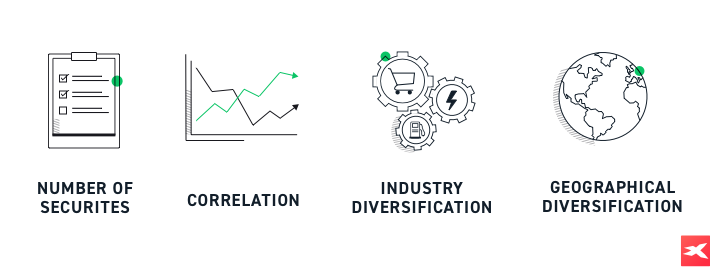 There are several simple ways to actually put some diversification strategies into use.
There are several simple ways to actually put some diversification strategies into use. 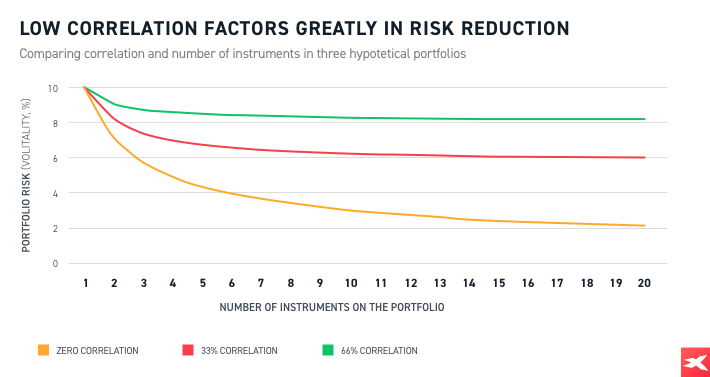 Please be aware that the presented data refers to the past performance data and as such is not a reliable indicator of future performance.
Please be aware that the presented data refers to the past performance data and as such is not a reliable indicator of future performance.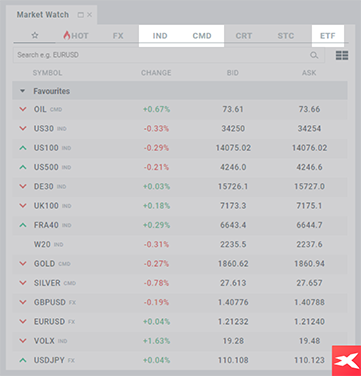 Please be aware that the presented data refers to the past performance data and as such is not a reliable indicator of future performance. Source: xStation5
Please be aware that the presented data refers to the past performance data and as such is not a reliable indicator of future performance. Source: xStation5 Please be aware that the presented data refers to the past performance data and as such is not a reliable indicator of future performance. Source: xStation5
Please be aware that the presented data refers to the past performance data and as such is not a reliable indicator of future performance. Source: xStation5 Please be aware that the presented data refers to the past performance data and as such is not a reliable indicator of future performance. Source: xStation5
Please be aware that the presented data refers to the past performance data and as such is not a reliable indicator of future performance. Source: xStation5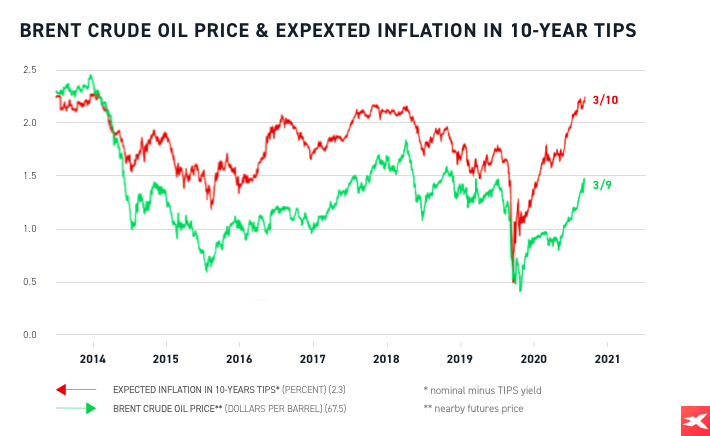 Please be aware that the presented data refers to the past performance data and as such is not a reliable indicator of future performance.
Please be aware that the presented data refers to the past performance data and as such is not a reliable indicator of future performance. Please be aware that the presented data refers to the past performance data and as such is not a reliable indicator of future performance.
Please be aware that the presented data refers to the past performance data and as such is not a reliable indicator of future performance.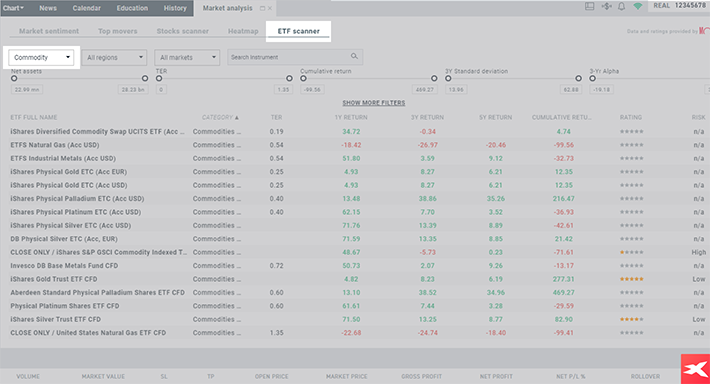 Please be aware that the presented data refers to the past performance data and as such is not a reliable indicator of future performance.
Please be aware that the presented data refers to the past performance data and as such is not a reliable indicator of future performance.